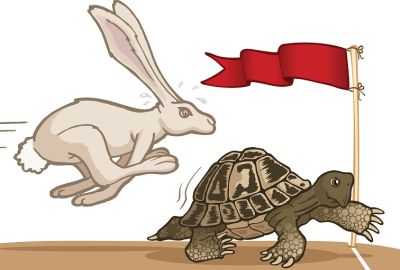Dec 17, 2025
Dec 17, 2025
The well-known proverb “Slow and steady wins the race” means that consistent progress leads to success, even when it appears that the others are ahead. It emphasizes patience and perseverance and teaches that the fastest will not always necessarily succeed. This proverb is often cited as the moral of the fable “The Hare and the Tortoise” written by Aesop.
 Fig. 1. The tortoise defeats the hare.
Fig. 1. The tortoise defeats the hare.
In that story, a hare and a tortoise agree to a foot race. After a while of the start, the hare looks back and observes the tortoise to be far behind. Assuring itself of victory, the hare decides to take a nap. But, it oversleeps and, when it comes out the sleep gets shocked to see that the tortoise has touched the finish line.
The question is “How good is the quoted proverb in light of the Fable?”. Does it make universal sense? The present article is an effort to address these two questions.
We realize that the rate of progress of a given activity can be FAST or SLOW. The progress can also simultaneously be STEADY or UNSTEADY. Thus there are four possible combinations to describe the progress. They will fit into the four quadrants of a square as shown in the figure below.

Fig. 2. Activity progress diagram
We can easily discern that the tortoise can be placed in Q3. The hare, on the other hand, has to be placed in Q2 because it took a break during its sprint for the nap. Thus the slow-and–steady-tortoise defeated the fast-but-unsteady-hare. So the key factor here is the “unsteadiness” of the hare because the tortoise did not put any extra effort. It just walked steadily at its normal speed.
Thus, for the success of any project or activity, we can say that unsteadiness must be avoided. The hare brought unsteadiness by coming to a dead stop. Unsteadiness is normally the result of backtracking or course corrections. Therefore, the quadrants Q1 and Q2 are detrimental and will affect severely the likelihood of success.
What about the pace of execution? We should note here that the hare-tortoise-race scenario is not representative of real-life situations. The tortoise had just one competitor to contend with and it was successful because of a blunder committed by the hare. In today’s highly competitive world, one has to contend with a large number of competitors. One cannot expect all of them to be blundering. A few may be peers and a few may be superior. So, one has to work compulsorily at his best possible pace. Thus there is little scope for deliberate slowness. Thus, to achieve success one has to focus on the quadrant Q3 and Q4.
The Hare and Tortoise fable is often taught in elementary schools. Should it be taught to young children with its morals? My opinion is that it be taught with two conditions. The first is that “slowness” is to be recommended only to avoid hasty actions. Secondly, the students should be taught the other important lesson. We know that the hare lost the race because of its overconfidence. So the moral is that complacency should always be avoided.